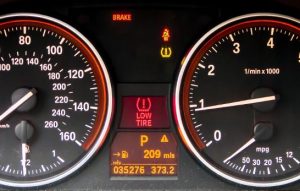TPMS FORECASTING: A GUIDE TO YOUR CAR’S TIRE PRESSURE SYSTEM
Posted October 9, 2019

TPMS = Tire Pressure Monitoring System. This warning notification system was introduced by our Federal Government following a series of fatal accidents that occurred in the late 90s and early 00s which spiraled into multiple legal proceedings and subsequently the development and mandate of tire pressure monitoring systems to be required in all vehicles.
As of Model Year 2008, all new vehicles in the U.S. have been equipped with an onboard tire pressure monitoring system per federal law. Some manufacturers jumped on this bandwagon as early as 2002 in the hopes of getting ahead of the trend and perhaps having a selling point advantage.
There are two types of TPMS systems. An indirect system is a system that uses the ABS wheel speed sensors to receive the current tire pressures, using velocity for calculations. Early Audi and Volkswagen cars and many Japanese and Domestic cars use the indirect systems. A direct system uses individual sensors to monitor / measure pressures. These systems are far more intelligent and can display individual pressures very accurately. BMW and Mercedes-Benz along with most modern day vehicles utilize the direct systems, which are costlier to maintain due to battery life expectancies, which I will extrapolate further in this post.
Most automobile owners loathe the tire pressure warning lamp, which is identified by a treaded horseshoe with an exclamation point in the center. These systems can be overly sensitive, or not sensitive enough, and many times the warning is either false or does not offer any information as to why the lamp is illuminated (some vehicles have more intelligent computer identifiers than others).
A solid TPMS warning lamp indicates low pressure in one or multiple tire(s). The most common cause of this warning lamp is reduced tire pressure, many times caused by sudden temperature changes or a tire resting on a curb / foreign object that puts more pressure than usual on a singular tire. This scenario can be mostly avoided by filling the tires with nitrogen, which is a heavier molecule than oxygen and does not escape as easily. Bead leakages and valve stem leakages or unidentified embedded screws or nails can be another source of leakage in a singular tire.
A flashing TPMS warning lamp indicates that there is a problem with the TPMS system, and does not necessarily mean that a tire is low. As I mentioned earlier in the post, direct TPMS systems are costlier to maintain. The reason for this is that each individual wheel has its own dedicated sensor with HEX identification characters. These are powered by a nickel cell battery which is soldered into the sensor and not serviceable. Battery life on direct TPMS sensors is 10 years, which most 2008-2011 vehicles are beginning to fall victim to. These direct systems are also equipped with antennas which receive the signal, and computer modules which communicate this information to the rest of the canbus. Indirect systems use the wheel speed sensors to send signals, which creates more warning messages such as ABS and Traction Control MILs when issues arise with the speed sensor(s) or wiring.
Special tools are in many cases required to perform a recalibration or reset of your TPMS system, though some vehicles are equipped with reset buttons or integrated settings within their respective infotainment systems. If there are malfunctions with any of the components in the TPMS system, special tools are 100% required and a service facility such as ours is the best way to identify and resolve the malfunction(s).
Many automobile owners don’t yet know that when it comes time to replacing tires, the age of the vehicle is very important to consider when your vehicle is equipped with a TPMS system. The reason for this is that it is far less expensive to replace all TPMS sensors in combination with your tires due to labor overlap. If the sensors are not close to end-of-life, TPMS service kits with new seals and caps are very important to have replaced, something our team recommends and performs on a regular basis but not all facilities focus on in the interest of cost savings / beating price quotes.
I will end with this information. If your vehicle is classic enough that it is not equipped with a TPMS system, please make a point to routinely check your tire pressures, especially when temperatures drop or rise. While tire pressure monitoring systems may inconvenience you once the warning lamp illuminates in your dash, these systems were developed with our safety in mind and are responsible for preventing many unexpected incidents along with saving lives. With modern life distractions many if not most of us are not habitual about checking our tire pressures regularly, and these systems when they work as designed pick up that slack for us.
-Rai Blanchette, Director of Operations
